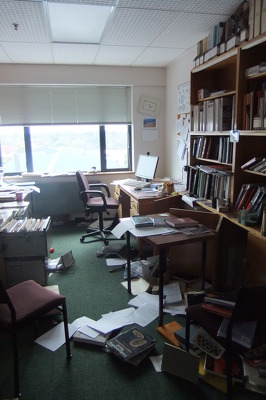
A photograph of an office in the Department of Civil and Natural Resources Engineering at the University of Canterbury after the 4 September 2010 earthquake.

A photograph of an office in the Department of Civil and Natural Resources Engineering at the University of Canterbury after the 4 September 2010 earthquake.

A photograph of an office in the Department of Civil and Natural Resources Engineering at the University of Canterbury after the 4 September 2010 earthquake.

A photograph of an office in the Department of Civil and Natural Resources Engineering at the University of Canterbury after the 4 September 2010 earthquake.

A photograph of an office in the Department of Civil and Natural Resources Engineering at the University of Canterbury after the 4 September 2010 earthquake.

A photograph of an office in the Department of Civil and Natural Resources Engineering at the University of Canterbury after the 4 September 2010 earthquake.

A photograph of an office in the Department of Civil and Natural Resources Engineering at the University of Canterbury after the 4 September 2010 earthquake.

A photograph of an office in the Department of Civil and Natural Resources Engineering at the University of Canterbury after the 4 September 2010 earthquake.

A photograph of an office in the Department of Civil and Natural Resources Engineering at the University of Canterbury after the 4 September 2010 earthquake.

A photograph of an office in the Department of Civil and Natural Resources Engineering at the University of Canterbury after the 4 September 2010 earthquake.

A photograph of an office in the Department of Civil and Natural Resources Engineering at the University of Canterbury after the 4 September 2010 earthquake.

A photograph of an office in the Department of Civil and Natural Resources Engineering at the University of Canterbury after the 4 September 2010 earthquake.

A photograph of an office in the Department of Civil and Natural Resources Engineering at the University of Canterbury after the 4 September 2010 earthquake.

A photograph of an office in the Department of Civil and Natural Resources Engineering at the University of Canterbury after the 4 September 2010 earthquake.

A photograph of an office in the Department of Civil and Natural Resources Engineering at the University of Canterbury after the 4 September 2010 earthquake.

A photograph of an office in the Department of Civil and Natural Resources Engineering at the University of Canterbury after the 4 September 2010 earthquake.

A photograph of the clock drive of the Townsend Telescope. The telescope is in the Observatory at the Christchurch Arts Centre. This image was used by Graeme Kershaw, Technician at the University of Canterbury Department of Physics and Astronomy, to identify the telescope's parts after the 22 February 2011 earthquake.

A photograph of the middle section of the Townsend Telescope. The telescope is in the Observatory at the Christchurch Arts Centre. This image was used by Graeme Kershaw, Technician at the University of Canterbury Department of Physics and Astronomy, to identify the telescope's parts after the 22 February 2011 earthquake.

Badly damaged in both the September and February quakes and over 6000 aftershocks the Point Pleasant yacht club had started to sink into the Avon estuary before being demolished in July 2011 after the June 6.3 earthquake

The faultline cuts across Telegraph Road, leaving a kink in its originally straight alignment; aftermath of the magnitude 7.1 earthquake in mid-Canterbury on Saturday 4 September 2010.

The faultline cuts across Telegraph Road, leaving a kink in its originally straight alignment; aftermath of the magnitude 7.1 earthquake in mid-Canterbury on Saturday 4 September 2010.

The faultline cuts across Telegraph Road, leaving a kink in its originally straight alignment; aftermath of the magnitude 7.1 earthquake in mid-Canterbury on Saturday 4 September 2010.

The faultline cuts across Telegraph Road, leaving a kink in its originally straight alignment; aftermath of the magnitude 7.1 earthquake in mid-Canterbury on Saturday 4 September 2010.

The faultline cuts across Telegraph Road, leaving a kink in its originally straight alignment; aftermath of the magnitude 7.1 earthquake in mid-Canterbury on Saturday 4 September 2010.

On the previously unknown faultline on Highfield Road in mid-Canterbury! This was where two tectonic plates slipped, causing the magnitude 7.1 earthquake on Saturday 4 September 2010.

The faultline cuts across Telegraph Road, leaving a kink in its originally straight alignment; aftermath of the magnitude 7.1 earthquake in mid-Canterbury on Saturday 4 September 2010.

The faultline cuts across Telegraph Road, leaving a kink in its originally straight alignment; aftermath of the magnitude 7.1 earthquake in mid-Canterbury on Saturday 4 September 2010.

A photograph of an exhibition sign next to the Speaker's Chair on display in the Canterbury Quakes exhibition at the Canterbury Museum. The Speaker's Chair stood at the southern end of the Stone Chamber of the Canterbury Provincial Chambers, and survived the 22 February 2011 earthquake despite the damage to the chamber.

The cartoon, which looks like a woodcut depicts a muscled workman wearing a black singlet; his arms are folded and the fingers of one hand are crossed. On his arms are tattoos of a helmet and pick, a '$' symbol, a petrol pump, and a high magnitude earthquake graph. Behind him are buildings, including the Christchurch Cathedral, damaged following the Christchurch earthquake of 22 February 2011. Below the cartoon are the words 'Apologies to Nigel Brown' - a black singlet is a recurring motif in the work of New Zealand artist Nigel Brown.
Quantity: 1 digital cartoon(s).

Damage to the St John The Evangelist Catholic Church in Leeston suffered during the magnitude 7.1 earthquake that struck mid-Canterbury on Saturday 4 September 2010.